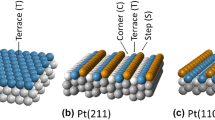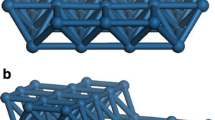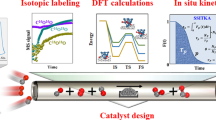Abstract
Sum frequency generation vibrational spectroscopy was applied in-situ during pyridine hydrogenation (10 Torr pyridine and 100 Torr hydrogen) over two well-defined platinum single crystals, Pt(100) and Pt(111). The surface reaction intermediates were clarified. Pyridine adsorbs to both crystals vertically, with in-tact aromatic ring. Over Pt(100) 1,4-dihydropyridine bound through the nitrogen was observed as a reaction intermediate, while over Pt(111) this was not detected. Upon heating the crystals from 300 to 350 K, the pyridine ring lies down flat on the catalyst surfaces. Over Pt(111) a tilted piperidine product is bound to the surface. Ring-cracking products were not observed over either surface.
Graphical Abstract

Similar content being viewed by others
1 Introduction
Catalytic reactions involving aromatic cyclic and heterocyclic molecules are important for the chemical industry for both fuel reforming and environmental concerns [1]. Hydrodenitrogenation chemistry is vitally important to the fuel reforming industry as nitrogen containing compounds inhibit the catalysts used for hydrodesulfurization through competitive adsorption [2] and act as a poison to acid catalysts [3]. Several recent works have focused on the understanding of the fundamental molecular level details of the adsorption and reaction of nitrogen containing aromatics on model platinum catalysts [4–7]. In general, molecular level studies of surface reactions are of paramount importance and is the subject of much current research [8]. Pyridine is a six-membered aromatic ring with one nitrogen heteroatom. The lone pair of electrons on the nitrogen atom is localized, meaning these electrons do not take part in the ring aromaticity. This means that pyridine is an electron donor, having the ability to donate electron density to a catalyst surface through either its π-aromatic orbitals or through σ-donation of the nitrogen lone pair to the surface.
One of the fundamental questions in pyridine adsorption to catalyst surfaces is whether it will bind through the aromatic orbitals, creating a parallel lying structure to a catalyst surface, or through lone-pair electron donation of the nitrogen atom creating a vertical structure on the surface. Haq and King [5] propose based on RAIRS data that at 300 K and higher over Pt(111) pyridine adsorbs at all coverages as an α-pyridyl surface intermediate by binding through the nitrogen atom, and cleaving the C-H bond from the α-carbon to create two bonds to the metal surface. Looking at 12 nm cubic Pt nanoparticles coated with TTAB, nanoparticles which express <100> facets selectively, Bratlie and Somorjai found that upon the coadsorption of pyridine and hydrogen on this catalyst surface, the pyridine is protonated at the nitrogen to create a pyridinium cation on the surface [4] as evidenced by a unique N–H stretching vibration at 3450 cm−1. The formation of pyridinium has been demonstrated by Lee and Masel over a Pt(110) single crystal under UHV conditions using HREELS upon the coadsorption of pyridine and hydrogen [7]. Haq and King demonstrate that the adsorption geometry of pyridine is coverage dependent, in that higher coverages tend toward tilted or upright adsorption geometries, while low surface coverages lead to parallel lying pyridine on the Pt(111) surface.
In order to clarify the surface bound reaction intermediates during pyridine hydrogenation over Pt and the effect of catalyst geometry on the reaction, sum frequency generation vibrational spectroscopy (SFG-VS) is applied in this work during pyridine hydrogenation at Torr pressures over well characterized Pt(111) and Pt(100) surfaces with the goal of determining the surface intermediates present from 300–400 K.
2 Experimental Section
2.1 Materials
Prior to use, pyridine (99.9%, Sigma-Aldrich Inc.) was subjected to several freeze-pump-thaw cycles and the purity was checked by means of gas chromatography.
2.2 The High-Pressure/Ultra-High Vacuum System
All experiments reported here were carried out in a high-pressure/ultrahigh-vacuum (HP/UHV) system. The UHV chamber is operated at a base pressure of 2 × 10−10 Torr and is isolated from the HP cell by a gate valve. The UHV system is equipped with an Auger electron spectrometer (AES), a quadrupole mass spectrometer (Stanford Research Systems) and an ion bombardment gun (Eurovac). The HP cell consists of two CaF2 conflat windows that allow transmission of infrared (IR), visible (VIS) and sum frequency radiation for sum frequency generation (SFG) experiments. The product gases in the HP cell are constantly mixed via a recirculation pump.
2.3 Sample Preparation
Prior to each experiment, the Pt(111) and Pt(100) crystal surfaces were cleaned in the UHV chamber by Ar+ (1 keV) sputtering for 20 min at about 5 × 10−5 Torr of Ar. After sputtering, the crystals were heated to 1103 K in the presence of O2 of 5 × 10−7 Torr and annealed at the same temperature for 2 min. The cleanliness of the crystal surfaces was verified by AES and the crystallographic structure verified with low energy electron diffraction (LEED). The samples were then transferred into the HP cell for SFG-VS measurements.
2.4 Sum Frequency Generation Vibrational Spectroscopy
For SFG measurements, an active/passive mode-locked Nd:YAG laser (Leopard D-20, Continuum) with a pulse width of 20 ps and a repetition rate of 20 Hz was used. The fundamental output at 1064 nm was sent through an optical parametric generation/amplification (OPA/OPG) stage where a tunable IR (2300–4000 cm−1) and a second harmonic VIS (532 nm) beam were created. The IR (150 μJ) and VIS (200 μJ) beams were spatially and temporally overlapped on the crystal surface at angles of incidence of 55 and 60°, respectively, with respect to the surface normal. The generated SFG beam was collected and sent through a motorized monochromator equipped with a photomultiplier tube to detect the SFG signal intensity. The signal-to-noise ratio was further increased by using a gated integrator while the IR beam was scanned through the spectral region of interest. The SFG process is enhanced when the IR beam comes into resonance with a vibrational mode of a molecule adsorbed at the surface, giving rise to a vibrational spectrum of adsorbed species. The frequency output of the OPG/OPA was calibrated and verified for each experiment by passing the IR beam through polystyrene and monitoring the absorption spectrum. More information on the HP/UHV system and SFG measurement can be found elsewhere [9–14].
3 Results and Discussion
For reference, the frequencies for possible surface reaction intermediates during the hydrogenation of pyridine over Pt catalysts reported in the literature are given in Table 1. In-tact pyridine on the Pt surface is characterized by an aromatic stretch at about 3060 cm−1, while the α-pyridyl intermediate gives stretches at 3087 and 3030 cm−1 [5]. The presence of the pyridinium cation reaction intermediate is associated with a unique N+–H stretch at 3450 cm−1 [4, 7]. 1,4-dihydropyridine is characterized by a pair of vinylic C=C–H stretches at the α and β carbons at about 3100 cm−1, with the α-carbon C=C–H stretch being blue shifted. In addition, 1,4-dihydropyridine has methylene symmetric and asymmetric stretches at the γ-carbon. The reaction product resulting from ring saturation, piperidine (Scheme 1), is characterized by only the methylene (CH2 symmetric and asymmetric) stretches in the C–H region. However, the methylene stretch at the α-carbon is blue-shifted from the methylene stretch of 1,4-dihydropyridine and therefore identifiable. Both adsorbed pyridine and the α-pyridyl intermediate have intact aromatic rings and differ only in the additional bonding of the α-carbon to the Pt surface in the case of α-pyridyl, and the spectra in the observed spectral range are thus too similar for differentiation.
3.1 SFG-VS Spectra During Pyridine Hydrogenation over Pt(100)
Figure 1 displays the sum frequency generation vibrational spectrum of 10 Torr pyridine and 100 Torr hydrogen over Pt(100) at 300 K. Two very strong resonances are observed. At 3050 cm−1 the C–H aromatic stretch is seen indicating the pyridine ring on the surface. The high intensity of this peak indicates the pyridine ring is in an upright adsorption geometry with respect to the surface at this surface coverage. A second dominant peak is observed at 2845 cm−1 corresponding to a CH2 symmetric stretch with a much weaker resonance seen at 2905 cm−1, assigned to the CH2 asymmetric stretch.
Temperature dependent SFG-VS spectra of 10 Torr pyridine and 100 Torr hydrogen over Pt(100). Two stretches are quite dominant in the spectrum at 300 K, the aromatic C–H and the symmetric methylene stretch indicating an upright structure on the Pt(100) surface. No N–H modes are observed. Evidence for the presence of a vertical pyridine structure at 300 K and 1,4-dihydropyridine as the sample is heated to 350 K is observed
The presence of the strong methylene stretches indicates that hydrogenated products are present on the surface with significant concentration. We assign these stretches to 1,4-dihydropyridine bound to the Pt(100) surface as the methyelene stretches from piperidine are expected to be further blue-shifted at the α-position as observed later over Pt(111). The high ratio of symmetric to asymmetric peak intensity of this CH2 moiety suggests an upright geometry for the 1,4-dihydropyridine ring. The lack of an N–H stretch indicates the 1,4-dihydropyridine is bound to the Pt(100) surface through the nitrogen atom, replacing the N–H bond.
Figure 1 further displays the temperature dependent SFG-VS spectra of 10 Torr pyridine and 100 Torr hydrogen over Pt(100) from 300–400 K. Upon heating to 350 K, the peak at 3050 cm−1 shrinks until it is comparable in size to a neighboring peak at 3100 cm−1. A peak at 3100 and 3050 cm−1 agrees with the C=C–H stretch at the α and β carbons respectively of 1,4-dihydropyridine. The rest of the spectrum remains unchanged up to 400 K. The disappearance of the dominant peak at 3050 cm−1 indicates the pyridine ring becomes more parallel to the Pt(100) surface at elevated temperatures due to the metal surface selection rule (MSSR). This is in agreement with the general trend observed in the literature [5, 7] that at lower coverages over platinum the pyridine ring adsorbs in a parallel fashion. Surface coverage σ by an adsorbate is defined as
where F is the incidenct flux of molecules and \( \tau \) is the surface residence time given by
where \( \tau_{0} \) is correlated to the surface atom vibration time (on the order of 10−12 s), \( \Updelta H_{ads} \) is the adsorption energy, T is the temperature, and R is the gas constant. Thus, as the temperature is raised the surface coverage goes down. This then agrees with the disappearance of the pyridine aromatic peak. As the temperature is raised, the surface coverage decreases with desorption, which has been previously observed to induce a parallel orientation of the pyridine ring. The disappearance of the aromatic stretch may also indicate decomposition of pyridine at elevated temperatures. However, the lack of any N–H decomposition product peaks in the spectrum eliminates this possibility. At the elevated temperatures the spectrum still agrees with the presence of vertical 1,4-dihydropyridine on the surface up to 400 K on Pt(100).
3.2 SFG-VS Spectra During Pyridine Hydrogenation over Pt(111)
To help elucidate the effect of catalyst structure, the results reported here over Pt(100) were compared to those acquired over a Pt(111) crystal. Figure 2 displays the temperature dependent SFG-VS spectra of 10 Torr pyridine and 100 Torr hydrogen over a Pt(111) single crystal from 300–400 K. At 300 K, a resonance is seen at 3060 cm−1 corresponding to the C–H aromatic stretch of either the pyridine molecule or the α-pyridyl intermediate. This stretch is not quite as dominant as the one seen over Pt(100).
The CH2 symmetric stretch is seen at 2865 cm−1 over Pt(111), 20 cm−1 to the blue of that observed on Pt(100) and no vinylic mode near 3100 cm−1 is observed. We assign the methylene stretches to the α-carbon CH2 stretching of piperidine on the surface. The methylene symmetric and asymmetric resonances are nearly equal in intensity, indicating that neither an upright nor flat-lying piperidine structure dominates on the surface but one which is tilted to some extent with respect to the surface normal. Upon heating the crystal to 350 K, the peak intensities all diminish significantly. Heating the crystal further to 400 K results in all of the modes nearly vanishing altogether. Only a small C–H aromatic resonance is still seen. This is likely due to increasing disorder on the surface at elevated temperatures. SFG-VS requires dipoles to be ordered in order to generate a signal, thus as molecules disorder, SFG-VS signal diminishes. The presence of the α-carbon methylene stretch and the disappearance of all modes other than the methylene stretches at 350 K indicates that we are seeing the saturated product piperidine on the surface, and that similarly to Pt(100), the pyridine ring lays more parallel at elevated temperatures. Scheme 2 summarizes the results for reaction intermediates found over Pt(100) and Pt(111). The presence of fully saturated products only on Pt(111), but not on Pt(100), indicates either an increased activation energy barrier from the 1,4-dihydropyridine to adsorbed piperidine reaction step over Pt(100), or a possibly higher sticking coefficient for the saturated product over the Pt(111) surface.
It is interesting to note that no N–H modes are observed during pyridine hydrogenation over Pt(111) or Pt(100). Recently, pyrrole hydrogenation has been studied over Pt(111) using SFG-VS and kinetics [6]. Pyrrole is the five-membered homologue to pyridine. In this case significant ring-cracking occurred over the Pt(111) surface to form straight-chain amines with clearly evident N–H modes in the SFG-VS spectra even at room temperature. However, no apparent ring-cracking is observed here for pyridine hydrogenation over Pt(111). The six-membered ring is more stable over the Pt surfaces. The lack of any N–H modes further indicates that the pyridinium cation intermediate is not present over Pt(111) or Pt(100) during catalytic hydrogenation. This is a clear and important difference from the results reported for TTAB coated Pt cubic nanoparticles [4], where the cation was observed. In addition to the possibility that catalyst size plays a role in this difference, it is likely that the TTAB stabilizing agent, which has a charged structure, may stabilize the cationic pyridinium structure over the Pt nanoparticles.
4 Conclusions
Sum frequency generation vibrational spectroscopy has been applied to the study of pyridine hydrogenation over two well-defined platinum single crystals, Pt(100) and Pt(111), to help elucidate the effect that catalyst structure has in the adsorption and reaction of pyridine. Relating this data to previously published work, the adsorption modes and reaction intermediates were clarified. Over Pt(100) the pyridine molecule adsorbs vertically, perpendicular to the metal surface. SFG-VS spectra reveal 1,4-dihydropyridine bound to the Pt(100) surface as an intermediate in the reaction. Upon heating the crystal to 350 K, the perpendicular pyridine resonance disappears, and the pyridine ring is adsorbed parallel to the metal surface while the 1,4-dihydropyridine remains. The intermediates remain constant upon heating further to 400 K. No evidence of an N–H mode on the surface was found, thus the 1,4-dihydropyridine is adsorbed through the N with a σ-bond. Further, no evidence of the proposed pyridinium cation intermediate was found on this surface, as was found over Pt(110) [7].
Over the Pt(111) crystal the pyridine adsorbs vertically as well. The hydrogenated product piperidine is present on the surface in a tilted geometry at 300 K. Upon heating the crystal to 350 K, the pyridine peak disappears indicating pyridine lays parallel on the surface at elevated temperature. Only the piperidine is visible at 350 K. Upon heating the Pt(111) crystal to 400 K the molecules disorder on the surface as all SFG resonant intensity vanishes.
References
Cooper BH, Donnis BBL (1996) Appl Catal A-Gen 137:203
Girgis MJ, Gates BC (1991) Ind Eng Chem Res 30:2021
Busca G (2007) Chem Rev 107:5366
Bratlie KM, Komvopoulos K, Somorjai GA (2008) J Phys Chem C 112:11865
Haq S, King DA (1996) J Phys Chem 100:16957
Kliewer CJ, Bieri M, Somorjai GA (2008) J Phys Chem C 112:11373
Lee IC, Masel RI (2002) J Phys Chem B 106:368
Somorjai GA, Kliewer CJ (2009) React Kinet Catal Lett 96:191
Bratlie KM, Flores LD, Somorjai GA (2005) Surf Sci 599:93
Kung KY, Chen P, Wei F, Rupprechter G, Shen YR, Somorjai GA (2001) Rev Sci Instrum 72:1806
Yang MC, Tang DC, Somorjai GA (2003) Rev Sci Instrum 74:4554
Shen YR (2003) The principles of nonlinear optics. Wiley, New Jersey
Shen YR (1989) Annu Rev Phys Chem 40:327
Shen YR (1989) Nature 337:519
Acknowledgment
This work was supported by the Director, Office of Energy Research, Office of Basic Energy Sciences, and Materials Sciences Division of the U.S. Department of Energy under Contract DE-AC02-05CH11231.
Open Access
This article is distributed under the terms of the Creative Commons Attribution Noncommercial License which permits any noncommercial use, distribution, and reproduction in any medium, provided the original author(s) and source are credited.
Author information
Authors and Affiliations
Corresponding author
Rights and permissions
Open Access This is an open access article distributed under the terms of the Creative Commons Attribution Noncommercial License (https://creativecommons.org/licenses/by-nc/2.0), which permits any noncommercial use, distribution, and reproduction in any medium, provided the original author(s) and source are credited.
About this article
Cite this article
Kliewer, C.J., Somorjai, G.A. Structure Effects on Pyridine Hydrogenation over Pt(111) and Pt(100) Studied with Sum Frequency Generation Vibrational Spectroscopy. Catal Lett 137, 118–122 (2010). https://doi.org/10.1007/s10562-010-0353-9
Received:
Accepted:
Published:
Issue Date:
DOI: https://doi.org/10.1007/s10562-010-0353-9








